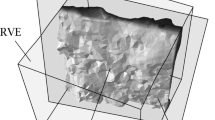Summary
Secondary stresses arising from the interaction of the heterogeneous components of concrete are shown to influence the elastic and time-dependent strains in all directions, even under a uniaxial compression. The influence of creep of aggregate and the stress at the aggregate-matrix interface under sustained load are also considered. It is suggested that superposition of strains under multiaxial stress is not valid.
Résumé
On montre que les contraintes secondaires engendrées par l'interaction des composants hétérogènes du béton agissent sur les déformations élastiques et sur la déformation en fonction du temps et dans toutes les directions, même en compression uniaxiale. On examine aussi l'effet du fluage des agrégats et les contraintes à l'interface agrégat-mortier sous charge permamente. On suggère que la superposition des déformations sous effort multiaxial n'est pas valiable.
Similar content being viewed by others
Abbreviations
- a:
-
aggregate
- c:
-
creep
- e:
-
elastic
- m:
-
matrix
- o:
-
circumferential
- r:
-
radial
- s:
-
secondary
- t:
-
time-dependent
- 1:
-
middle part
- 2:
-
outer part
- A:
-
cross-sectional area
- E:
-
modulus of elasticity
- f:
-
overall applied stress
- p:
-
time-dependent change in secondary radial stress at the interface of the middle part of the model
- p′:
-
initial radial stress at interface
- p:
-
change in radial stress at interface due to interaction of the outer and middle parts of the model
- V:
-
volume concentration
- ε:
-
strain
- σ:
-
stress
- σ′:
-
initial stress
- σs :
-
secondary circumferential stress
- ν:
-
Poisson's ratio
References
Counto, U. J.—“The effect of elastic modulus of aggregate on the elastic modulus, creep and creep recovery of concrete”, Magazine of Concrete Research, Vol. 16, No. 48, Sept. 1964, pp. 129–138.
Neville, A. M.—“Theories of creep in concrete”, ACI Journal, Proceedings, Vol. 52, Sept. 1955, pp. 47–60.
Ross, A. D.—“Concrete creep data”, Structural Engineer, Vol. 15, No. 8, Aug. 1937, pp. 314–326.
Neville, A. M.—“Creep of concrete as a function of its cement paste content”, Magazine of Concrete Research, Vol. 16, No. 46, March 1964, pp. 21–30.
Neville, A. M.—“Properties of concrete”, Sir Isaac Pitman and Sons Ltd., London, 1963, John Wiley and Sons Ltd., New York, 1964, Reprinted June 1970, p. 532.
Gopalakrishnan, K. S., Neville, A. M. andGhali, Amin.—“Creep Poisson's ratio of concrete under multiaxial compression”, ACI Journal, Proceedings, Vol. 66, Dec. 1969, pp. 1008–1020.
Bridgman, P. W.—“Studies in large plastic flow and fracture”, McGraw-Hill Book Co., Inc., New York, 1952, p. 362.
Vile, G. W. D.—“Behaviour of concrete under simple and combined stresses”, Ph.D. Thesis, University of London, 1964, p. 559.
Robinson, G. S.—“Behaviour of concrete in biaxial compression”, Journal of the Structural Division, ASCE, Proceedings, Vol. 93, No. ST 1, Feb. 1967, pp. 71–86.
Gopalakrishnan, K. S.—“Creep of concrete under multiaxial compressive stresses”, Ph.D. Thesis University of Calgary, April 1968.
Author information
Authors and Affiliations
Rights and permissions
About this article
Cite this article
Gopalakrishnan, K.S., Neville, A.M. & Ghali, A. Elastic and time-dependent effects of aggregate-matrix interaction. Mat. Constr. 3, 225–236 (1970). https://doi.org/10.1007/BF02474011
Issue Date:
DOI: https://doi.org/10.1007/BF02474011




